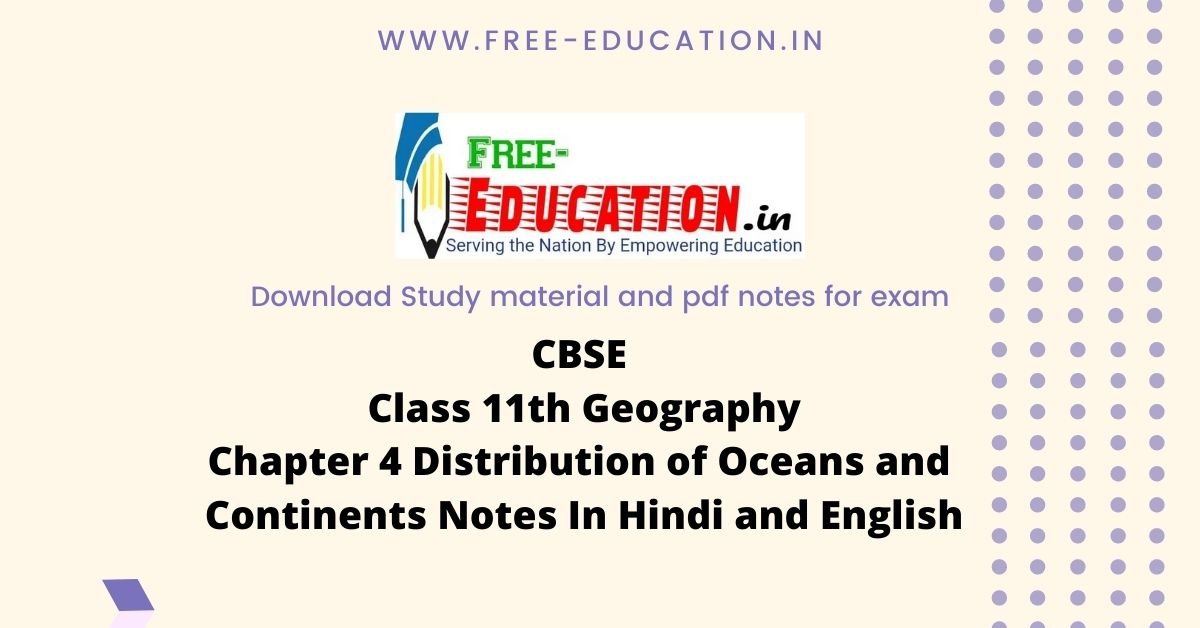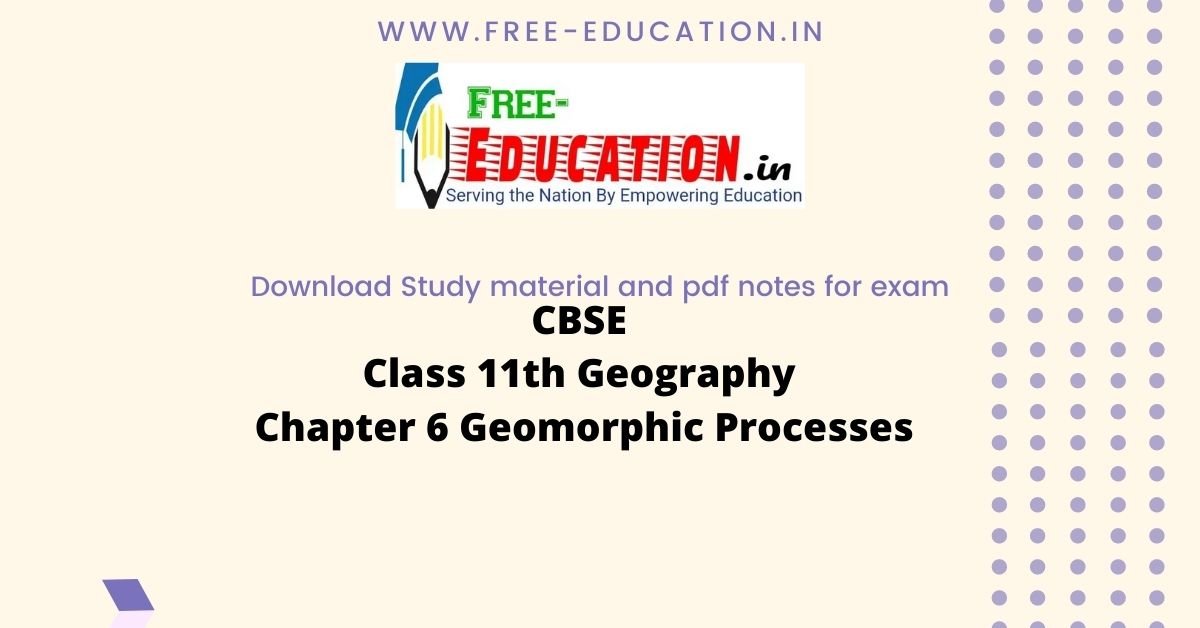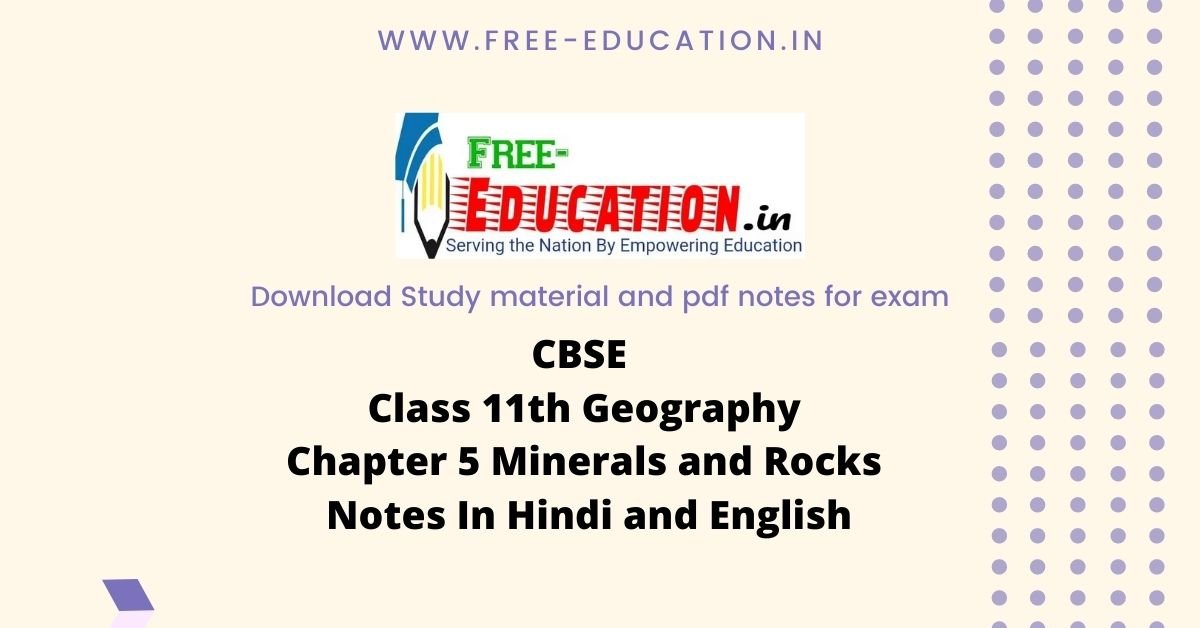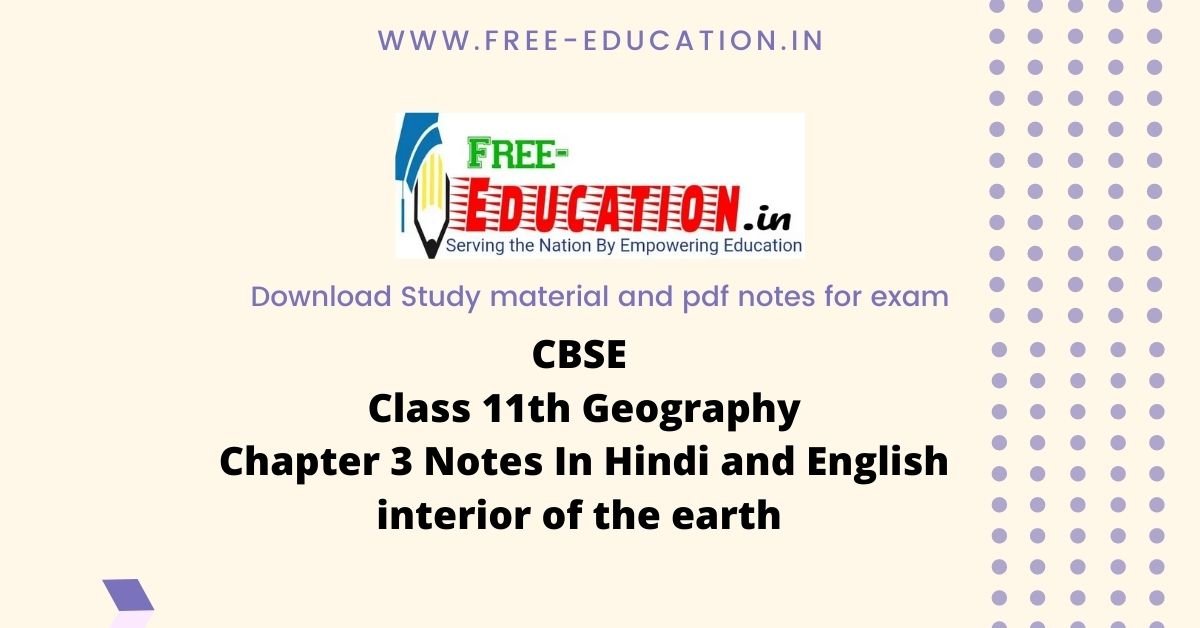Class 11 Geography NCERT Solutions Chapter 4 Distribution of Oceans and Continents
Class 11 Geography Chapter 4 NCERT Textbook Questions Solved
1. Multiple choice questions
Question 1(i).
Who amongst the following was the first to consider the possibility of Europe, Africa and America having been located side by side?
(а) Alfred Wegener
(b) Antonio Pellegrini
(c) Abraham Ortelius
(d) Edmond Hess.
Answer:
(c) Abraham Ortelius
Question 1(ii).
Polar fleeing force relates to:
(a) Revolution of the Earth
(b) Gravitation
(c) Rotation of the earth
(d) Tides.
Answer:
(c) Rotation of the earth
Question 1(iii).
Which one of the following is not a minor plate?
(a) Nazca
(b) Arabia
(c) Philippines
(d) Antarctica.
Answer:
(d) Antarctica
Question 1(iv).
Which one of the following facts was not considered by those while discussing the concept of sea floor spreading?
(a) Volcanic activity along the mid- oceanic ridges
(b) Stripes of normal and reverse magnetic field observed in rocks of ocean floor
(c) Distribution of fossils in different continents
(d) Age of rocks from the ocean floor.
Answer:
(c) Distribution of fossils in different continents
Question 1(v).
Which one of the following is the type of plate boundary of the Indian plate along the Himalayan Mountains?
(а) Ocean-continent convergence
(b) Divergent boundary
(c) Transform boundary
(d) Continent-continent convergence.
Answer:
(d) Continent-continent convergence.
2. Answer the following questions in about 30 words.
Question 2(i).
What were the forces suggested by Wegener for the movement of the continents?
Answer:
Wegener suggested that the movement responsible for the drifting of the continents was caused by two forces.
- Pole-fleeing force and
- Tidal force.
The polar-fleeing force relates to the rotation of the earth. The earth is not a perfect sphere; it has a bulge at the equator. This bulge is due to the rotation of the earth.
The tidal force is due to the attraction of the moon and the sun that develops tides in oceanic waters. Wegener believed that these forces would become effective when applied over many million years.
Question 2(ii). ( Distribution of Oceans and Continents )
How are the convectional currents in the mantle initiated and maintained?
Answer:
Arthur Holmes in 1930s discussed the possibility of convection currents operating in the mantle portion. These currents are generated due to radioactive elements causing thermal differences in the mantle portion. According to Holmes, there exists a system of such currents in the entire mantle portion. This was an attempt to provide an explanation to the issue of force, on the basis of which contemporary scientists discarded the continental drift theory.
Question 2(iii). ( Distribution of Oceans and Continents )
What is the major difference between the transform boundary and the convergent or divergent boundaries of plates?
Answer:
The major difference between the transform boundary and the convergent or divergent boundaries of plates are as follows:
- Transform Boundaries: Where the crust is neither produced nor destroyed as the plates slide horizontally past each other.
- Convergent Boundaries: Where the crust is destroyed as one plate dived under another, it is called convergent boundaries.
- Divergent Boundaries: Where new crust is generated as the plates pull away from each other, these are called divergent boundaries.
Question 2(iv). ( Distribution of Oceans and Continents )
What was the location of the Indian landmass during the formation of the Deccan Traps?
Answer:
About 140 million years before the present, the subcontinent was located as south as 50°S latitude. During the movement of the Indian plate towards the Asiatic plate, a major event that occurred was the outpouring of lava and formation of the Deccan Traps. This started somewhere around 60 million years ago and continued for a long period of time. Note that the subcontinent was still close to the equator. From 40 million years ago and thereafter, the event of formation of the Himalayas took place. Scientists believe that the process is still continuing and the height of the Himalayas is rising even to this date.
3. Answer the following questions in about 150 words.
Question 3(i) .
What are the evidences in support of the continental drift theory?
Answer:
A variety of evidence was offered in support of the continental drift. Some of these are given below:
1. The Matching of Continents (Jig-Saw-Fit): The shorelines of Africa and South America facing each other have a remarkable and unmistakable match.
2. Rocks of Same Age Across the Oceans: The belt of ancient rocks of 2,000 million years from Brazil coast matches with those from western Africa. The earliest marine deposits along the coastline of South America and Africa are of the Jurassic age. This suggests that the ocean did not exist prior to that time.
3. Tillite: It is the sedimentary rock formed out of deposits of glaciers. The Gondawana system of sediments from India is known to have its counter parts in six -different landmasses of the Southern Hemisphere. At the base the system has thick tillite indicating extensive and prolonged glaciation. Counter parts of this succession are found in Africa, Falkland Island, Madagascar, Antarctica and Australia besides India. Overall resemblance of the Gondawana type sediments clearly demonstrates that these landmasses had remarkably similar histories. The 45 glacial tiilite provides unambiguous evidence of palaeoclimates and also of drifting of continents.
4. Placer Deposits: The occurrence of rich placer deposits of gold in the Ghana coast and the absolute absence of source rock in the region is an amazing fact. The gold bearing veins are in Brazil and it is obvious that the gold deposits of the Ghana are derived from the Brazil . plateau when the two continents lay side by side.
5. Distribution of Fossils: The observations that Lemurs occur in India, Madagascar and Africa led some to consider a contiguous landmass “Lemuria” linking these three landmasses. Mesosaurus was a small reptile adapted to shallow brackish water. The skeletons of these are found only in two localities : the Southern Cape province of South Africa and Iraver formations of Brazil. The two localities presently are 4,800 km apart with an ocean in between them.
Question 3(ii). ( Distribution of Oceans and Continents )
Bring about the basic difference between the drift theory and Plate tectonics.
Answer:
Drift theory: Alfred Wegener a German meteorologist put forth “the continental drift theory”. According to him, all continents formed a single continental mass called PANGAEA All oceans formed a single universal ocean called PANTHALASSA. He argued that, around 200 million years ago, the super continent, Pangaea, began to split. Pangaea first broke into two large continental masses as Laurasia and Gondwanaland forming the northern and southern components respectively. Subsequently, Laurasia and Gondwan al and continued to break into various smaller continents that exist today.
Plate Tectonics: This theory emerged in 1967, by McKenzie and Parker and also Morgan. A tectonic plate is also called lithospheric plate. It is a massive, irregularly-shaped slab of solid rock, generally composed of both continental and oceanic lithosphere. Plates move horizontally over the asthenosphere as rigid units. The lithosphere includes the crust and top mantle with its thickness range varying between 5-100 km in oceanic parts and about 200 km in the continental areas. Pacific plate is largely an oceanic plate whereas the Eurasian plate may be called a continental plate. The theory of plate tectonics proposes that the earth’s lithosphere is divided into seven major and some minor plates.
Question 3(iii). ( Distribution of Oceans and Continents )
What were the major post-drift discoveries that rejuvenated the interest of scientists in the study of distribution of oceans and continents?
Answer:
A number of discoveries during the post¬war period added new information to geological literature. Particularly, the information collected from the ocean floor mapping provided new dimensions for the study of distribution of oceans and continents.
- These currents are generated due to radioactive elements causing thermal differences in the mantle portion. Holmes argued that there exists a system of such currents in the entire mantle portion. This was an attempt to provide an explanation to the issue of force, on the basis of which contemporary scientists discarded the continental drift theory.
- Detailed research of the ocean configuration revealed that the ocean floor is not just a vast plain but it is full of relief.
- Expeditions to map the oceanic floor in the post-war period provided a detailed picture of the ocean relief and indicated the existence of submerged mountain ranges as well as deep trenches, mostly located closer to the continent margins.
- The mid-oceanic ridges were found to be most active in terms of volcanic eruptions. The dating of the rocks from the oceanic crust revealed the fact that they are much younger than the continental areas.
- Rocks on either side of the crest of oceanic ridges and having equi-distant locations from the crest were found to have remarkable similarities both in terms of their constituents and their age.
Class 11 Geography Chapter 4 NCERT Extra Questions
Class 11 Geography Chapter 4 Multiple Choice Questions
Question 1. ( Distribution of Oceans and Continents )
Name the smallest continent.
(a) Asia
(b) Europe
(c) Africa
(d) Australia.
Answer:
(d) Australia.
Question 2. ( Distribution of Oceans and Continents )
Who was the profbunder of plate tectonic theory?
(a) Arthur Holmes
(b) McKenzie, Parker and Morgan
(c) Admans Heinz
(d) Alfred Wegener.
Answer:
(b) McKenzie, Parker and Morgan
Question 3. ( Distribution of Oceans and Continents )
Who was the profounder of convection currents theory?
(a) Arthur Holmes
(b) McKenzie, Parker and Morgan
(c) Admans Heinz
(d) Alfred Wegener.
Answer:
(a) Arthur Holmes
Question 4. ( Distribution of Oceans and Continents )
(iii) Pacific Ocean zone is also called:
(a) Ring of Fire
(b) Ball of Fire
(c) Fire rain area
(d) Volcanic area.
Answer:
(a) Ring of Fire
Question 5. ( Distribution of Oceans and Continents )
Which country has gold bearing veins?
(a) Australia
(b) Russia
(c) Brazil
(d) South Africa.
Answer:
(c) Brazil
Question 6. ( Distribution of Oceans and Continents )
By which method have facilitated correlating the rock formation from different continents across oceans?
(a) The radiometric dating methods
(b) Carbon 14 method
(c) Radioactive method
(d) Fling Method.
Answer:
(a) The radiometric dating methods
Question 7. ( Distribution of Oceans and Continents )
The ocean floor may be segmented into how many divisions based on the depth as well as the forms of relief?
(a) Three
(b) Four
(c) Five
(d) Seven.
Answer:
(a) Three
Question 8. ( Distribution of Oceans and Continents )
What per cent of the earth is covered with land and water respectively?
(a) 29% of the earth is covered with land and 71% is covered with water.
(b) 71% of the’earth is covered with land and 29% is covered with water.
(c) 36% of the earth is covered with land and 64% is covered with water.
(d) 64% of the earth is covered with land and 36% is covered with water.
Answer:
(a) 29% of the earth is covered with land and 71% is covered with water.
Question 9. ( Distribution of Oceans and Continents )
What was the name given by Alfred Wegener to a large continent surrounded with water?
(a) Pangaea
(b) Panthalassa
(c) Angaraland
(d) Gondwanaland.
Answer:
(a) Pangaea
Question 10. ( Distribution of Oceans and Continents )
Who was the profounder of continental drift theory?
(а) Arthur Holmes
(b) McKenzie, Parker and Morgan
(c) Admans Heinz
(d) Alfred Wegener.
Answer:
(d) Alfred Wegener.
Question 11. ( Distribution of Oceans and Continents )
What was the name given to massive ocean by Wegener?
(a) Pangaea
(b) Panthalassa
(c) Angara land
(d) Gondwanaland.
Answer:
(b) Panthalassa
Question 12.
According to Wegener, Pangaea was divided into land forms namely:
(a) Panthalassa and Angara Land
(b) Lurasia and Gondwanaland
(c) Livasa and Continent
(d) Oceans and Continents.
Answer:
(b) Lurasia and Gondwanaland.
Class 11 Geography Chapter 4 Very Short Answer Type Questions
Question 1.
What was the theory’ profounded by Alfred Wegener, a German meteorologist? With what principle was it associated?
Answer:
Alfred Wegener, a German meteorologist put forth a comprehensive argument in the form of “the continental drift theory” in 1912. This was regarding the distribution of the oceans and the continents.
Question 2.
Which methods that developed in the recent period have facilitated correlating the rock formation from different continents across the vast ocean?
Answer:
The radiometric dating methods developed in the recent period have facilitated correlating the rock formation from different continents across the vast ocean.
Question 3.
What are Abyssal Plains?
Answer:
These are extensive plains that lie between the continental margins and mid-oceanic ridges. The Abyssal plains are the areas where the continental sediments that move beyond the margins get deposited.
Question 4.
What are Continental Margins?
Answer:
These form the transition between continental shores and deep-sea basins. They include continental shelf, continental slope, continental rise and deep-oceanic trenches.
Question 5.
What are convection currents?
Answer:
Convection currents are generated due to radioactive elements causing thermal differences in the mantle portion.
Question 6.
What was the condition of India when Pangaea broke? Before that what was the status of India?
Answer:
India was a large island situated off the Australian coast, in a vast ocean. The Tethys sea separated it from the Asian continent till about 225 million years ago. India is supposed to have started her northward journey about 200 million years ago at the time when Pangaea broke. India collided with Asia about 40¬50 million years ago causing rapid uplift of the Himalayas.
Question 7.
How was Himalaya formed?
Answer:
India started her northward journey about 200 million years ago at the time when Pangaea broke. India collided with Asia about 40-50 million years ago causing rapid uplift of the Himalayas.
Question 8.
How was Deccan Traps formed?
Answer:
During the movement of the Indian plate towards the Asiatic plate, a major event that occurred was the outpouring of lava. It led to formation of the Deccan Traps. This started somewhere around 60 million years ago and continued for a long period of time.
Question 9.
What was emphasised by the sea floor spreading and tectonic plates theory?
Answer:
It emphasised that the earth is divided into plates and these plates have been constantly moving over the globe throughout the history of the earth. It is not the continent that moves as believed by Wegener. Continents are part of a plate and what moves is the plate. All the plates, without exception, have moved in the geological past, and shall continue to move in the future as well.
Question 10.
What are the different ways in which convergence can take place?
Answer:
There are three ways in which convergence can occur.
These are:
- between an oceanic and continental plate;
- between two oceanic plates; and
- between two continental plates.
Question 11.
Who was the profounder of plate tectonic theory?
Answer:
McKenzie Parker and Morgan
Question 12.
Who was the profounder of convection currents theory?
Answer:
Arthur Holmes
Question 13.
According to Wegener, what are the causes of drifting of continents?
Answer:
Two causes were responsible for the drifting of the continents:
- Pole-fleeing force and
- Tidal force.
Question 14.
In how many plates has earth been divided according to plate tectonic theory?
Answer:
According to this theory, the earth has been divided into seven major and some minor plates.
Question 15.
Give examples of placer deposits.
Answer:
The occurrence of rich placer deposits of gold in the Ghana coast and the gold bearing veins in Brazil are examples of placer deposits.
Question 16.
With what is fleeing force related?
Answer:
The polar-fleeing force relates to the rotation of the earth. The earth is not a perfect sphere; it has a bulge at the equator. This bulge is due to the rotation of the earth.
Question 17.
With what is tidal force related?
Answer:
It is related to the attraction of the moon and the sun that develops tides in oceanic waters. Wegener believed that these forces would become effective when applied over many million years.
Question 18.
On what basis has continent drifting theory been discarded?
Answer:
Arthur Holmes in 1930s discussed the possibility of convection currents operating in the mantle portion. These currents are generated due to radioactive elements causing thermal differences in the mantle portion. Holmes argued that there exists a system of such currents in the entire mantle portion. This was an attempt to provide an explanation to the issue of force, on the basis of which contemporary scientists discarded the continental drift theory.
Question 19.
The ocean floor may be segmented into howr many di visions based on the depth as well as the forms of relief?
Answer:
The ocean floor may be segmented into three major divisions based on the depth as well as the forms of relief. These divisions are:
- continental margins,
- deep-sea basins and
- mid-oceanic ridges.
Question 20.
What are mid-oceanic ridges?
Answer:
This forms an interconnected chain of mountain system within the ocean. It is the longest mountain-chain on the surface of the earth though submerged under the oceanic water. It is characterised by a central rift system at the crest, a fractionated plateau and flank zone all along its length. The rift system at the crest is the zone of intense volcanic activity.
Question 21.
Which fact helped the scientists to understand plate movement?
Answer:
The rocks equidistant on either sides of the crest of mid-oceanic ridges show remarkable similarities in terms of period of formation, chemical compositions and magnetic properties. Rocks closer to the mid-oceanic ridges have normal polarity and are the youngest. The age of the rocks increases as one moves away from the crest.
Class 11 Geography Chapter 4 Short Answer Type Questions
Question 1.
Explain the movement in Indian plate.
Answer:
The Indian plate includes Peninsular India and the Australian continental portions. The Tethys Sea separated it from the Asian continent till about 225 million years ago. India is supposed to have started her northward journey about 200 million years ago at the time when Pangaea broke. India collided with Asia about 40-50 million years ago causing rapid uplift of the Himalayas. About 140 million years before the present, the subcontinent was located as south as 50°S. latitude.
The two major plates were separated by the Tethys Sea and the Tibetan block was closer to the Asiatic landmass. During the movement of the Indian plate towards the Asiatic plate, a major event that occurred was the outpouring of lava and formation of the Deccan Traps. This started somewhere around 60 million years ago and continued for a long period of time. The subcontinent was still close to the equator. From 40 million years ago and thereafter, the event of formation of the Himalayas took place. Scientists believe that the process is still continuing and the height of the Himalayas is rising even to this date.
Question 2.
Explain the hypothesis, known as the “sea floor spreading” given by Hess.
Answer:
Hess argued that constant eruptions at the crest of oceanic ridges cause the rupture of the oceanic crust forces and the new lava wedges into it, pushing the oceanic crust on either side. The ocean floor, thus spreads. Two facts made Hess think about the consumption of the oceanic crust.
- The younger age of the oceanic crust
- The spreading of one ocean does not cause the shrinking of the other.
He further maintained that the ocean floor that gets pushed due to volcanic eruptions at the crest, sinks down at the oceanic trenches and gets consumed. The basic concept of sea floor spreading has been depicted in the given figure:

Question 3.
Explain the distribution of earthquake and volcanic plate on the earth,
Answer:
Earthquake and Volcanic plate:
1. It goes from Atlantic Ocean almost parallel to the coastlines. It further extends into the Indian Ocean. It bifurcates a little south of the Indian subcontinent with one branch moving into East Africa and the other meeting a similar line from Myanmar to New Guiana.
2. Another area of concentration coincides with the Alpine-Himalayan system and the rim of the Pacific Ocean. In general, the foci of the earthquake in the areas of mid-oceanic ridges are at shallow depths whereas along the Alpine-Himalayan belt as well as the rim of the Pacific, the earthquakes are deep-seated ones. The map of volcanoes also shows a similar pattern. The rim of the Pacific is also called rim of fire due to the existence of active volcanoes in this area.
Question 4.
What information do we get from the mapping of the ocean floor and palaeomagnetic studies of rocks from oceanic regions?
Answer:
The mapping of the ocean floor and palaeomagnetic studies of rocks from oceanic regions gave following information:
- Along the mid-oceanic ridges, volcanic eruptions are common and they bring huge amounts of lava to the surface in this area.
- The rocks equidistant on either sides of the crest of mid-oceanic ridges show remarkable similarities in terms of period of formation, chemical compositions and magnetic properties.
- The ocean crust rocks are much younger than the continental rocks. The age of rocks in the oceanic crust is nowhere more than 200 million years old. Some of the continental rock formations are as old as 3,200 million years.
- The sediments on the ocean floor are unexpectedly very thin. Scientists expected that if the ocean floors were as old as the continent, to have a complete sequence of sediments for a period of much longer duration. However, nowhere was the sediment column found to be older than 200 million years.
- The deep trenches have deep-seated earthquake occurrences while in the mid-oceanic ridge areas, the quake foci have shallow’ depths.
Question 5.
Explain the basic concept of continental drift theory.
Answer:
Alfred Wegener, a German meteorologist, put forth a comprehensive argument in the form of “the continental drift theory” in 1912. This was regarding the distribution of the oceans and the continents. According to Wegener, all the continents formed a single continental mass and mega ocean surrounded the same. He called the super continent as PANGAEA, meaning all earth. He named mega ocean as PANTHALASSA, meaning all water. According to him. around 200 million years ago, the super continent, Pangaea, began to split. Pangaea first broke into two large continental masses as Laurasia and Gondwanaland forming the northern and southern components respectively. Subsequently, Laurasia and Gondwanalan d continued to break into various smaller continents that exist today. A variety of evidence was offered in support of the continental drift.
Question 6.
Explain different types of boundaries that form as a result of tectonic plates.
Answer:
Three types of boundaries are formed as a result of tectonic plates:
- Convergent Boundaries: Where the crust is destroyed as one plate dived under another, it is called convergent boundaries.
- Divergent Boundaries: Where new crust is generated as the plates pull away from each other, these are called divergent boundaries.
- Transform Boundaries: Where the
crust is neither produced nor destroyed as the plates slide horizontally past each other. ,
Class 11 Geography Chapter 4 Long Answer Type Questions
Question 1.
According to tectonic plates theory in how many plates has the earth been divided? Explain.
Answer:
The theory of plate tectonics proposes that the earth’s lithosphere is divided into seven major and some minor plates. The major plates are as follows:
- Antarctica and the surrounding oceanic plate
- North American plate
- South American plate
- Pacific plate
- India-Australia-New Zealand plate
- Africa with the eastern Atlantic floor plate
- Eurasia and the adjacent oceanic plate. Some important minor plates are:
- Cocos plate: It is between Central America and Pacific plate
- Nazca plate: It is between South America and Pacific plate
- Arabian plate: It includes mostly the Saudi Arabian landmass
- Philippine plate: It is between the Asiatic and Pacific plate
- Caroline plate: It is between the Philippine and Indian plate (North of New Guinea)
- Fuji plate: It includes North-east of Australia.
- Pacific plate is largely an oceanic plate whereas the Eurasian plate may be called a continental plate. Plates are not static. Plates may converge or diverge. Plates may break as well.
Question 2.
Explain tectonic plate theory and its j working.
Answer:
These plates have been constantly moving over the globe throughout the history of the earth.
- The theory of plate tectonics was introduced by Mckenzie, Parker and , Morgan in 1967.
- A tectonic plate is also called as lithosphere plate.
- It is a massive irregularly shaped slab of solid rock.
- Consists of oceanic and continental sphere.
- Plates move horizontally over the asthenosphere.
- Average thickness is 100 km of oceanic part and 200 km of continental part.
- It may be oceanic or continental.
- Pacific plate is largest oceanic plate whereas Eurasian plate is the largest continental plate.
- These plates are moving constantly throughout geological time not the continent, believed by Wegener.
It creates three types of boundaries.
- Divergent boundaries
- New crust is generated
- Plates move away from each other
- These are called spreading sites
- Ex. Mid atlantic ridge
- Convergent boundaries |
- Crust is destroyed
- Sinking of plate is called “subduction zone”. There are three ways in which subduction occurs (i) between an oceanic and continental plates; (ii) between two oceanic plates; and (iii) between two continental plates.
- Transform boundaries: Where the crust is neither produced nor destroyed as the plates slide horizontally past each other.
Question 3.
Explain important theories associated with the movement of continents.
Answer:
Continental drift: Abraham Ortelius a Dutch map maker in 1596 first proposed the possibility of joining the continents such as America with Europe and Africa. Antonio Pellegrini drew a map showing the three continents together. Alfred Wegener, a German meteorologist put forth the continental drift theory. According to him, all continents formed a single continental mass called Pangaea.
All oceans formed a single universal ocean called Panthalassa around 200 million years ago. The Pangaea began to split into two large continental masses called Laurasia and Gondwanaland. By further splitting Laurasia formed northern continents and Gondwanaland formed southern continents.
Sea Floor Spreading: The deep trenches have deep-seated earthquake occurrences while in the mid- oceanic ridge areas, the quake foci have shallow depths. These facts and a detailed analysis of magnetic properties of the rocks on either sides of the mid-oceanic ridge led Hess in 1961 to propose his hypothesis. It was called the “sea floor spreading”. Hess argued that constant eruptions at the crest of oceanic ridges cause the rupture of the oceanic crust forces and the new lava wedges into it, pushing the oceanic crust on either side. The ocean floor, thus spreads. Two facts made Hess think about the consumption of the oceanic crust.
- The younger age of the oceanic crust.
- The spreading of one ocean does not cause the shrinking of the other.
He further maintained that the ocean floor that gets pushed due to volcanic eruptions at the crest, sinks down at the oceanic trenches and gets consumed. Plate Tectonics: It was in 1967, McKenzie and Parker and also Morgan, independently collected the available ideas and came out with another concept termed Plate Tectonics. The theory of plate tectonics proposes that the earth’s lithosphere is divided into seven major and some minor plates. These plates have been constantly moving over the globe throughout the history of the earth. It is not the continent that moves as believed by Wegener. Continents are part of a plate and what moves is the plate. All the plates, without exception, have moved in the geological past, and shall continue to move in the future as well.
Question 4.
The ocean floor may be segmented into how many divisions based on the depth as well as the forms of relief?
Answer:
The ocean floor may be segmented into three major divisions based on the depth as well as the forms of relief. These divisions are:
(i) Continental margins,
(ii) Abyssal plains and
(iii) Mid-oceanic ridges.
- Continental margins
- Form transitional zone between continental shore and deep sea basins
- They include continental slope , shelf, continental rise and deep oceanic trenches
- Abyssal plains
- Extensive plains
- Found between continental margin and mid oceanic ridge
- Continental sediments get deposited
- Mid-oceanic ridges
- Distribution of volcanoes and earthquakes
- All volcanoes and earthquakes are parallel to the coast
- This line also co-incides with mid- Atlantic ridge and Alpine Himalayan system
- Around the Pacific Ocean it is called ring of fire mid oceanic ridges.
Class 11 Geography Chapter 4 Hots Questions
Question 1.
The rate of plate movement varies considerably. Justify.
Answer:
It is very rightly said. The strips of normal and reverse magnetic field that parallel the mid-oceanic ridges help scientists determine the rates of plate movement. These rates vary considerably.
- Slowest Rate: The Arctic Ridge has the slowest rate. It is less than 2.5 cm/yr.
- Fastest Rate: The East Pacific rise near Easter Island, in the South Pacific about 3,400 km west of Chile, has the fastest rate. It is more than 15 cm/yr.
Map Skill
Question 1.
Show on the physical map of the world,
- The Tectonic Plates
- Volcanic Eruptions
- Ring of Fire
- Hot Spots.

Related link you must like:-
Study material for Competition Exam
Mohd. Sharif Qualification: B.Tech (Mechanical Engineering) [Founder of Wisdom Academy] [Aim Foundation & Free-Education.In] [Engineer By Profession | Teacher By Choice] [Blogger, YouTube Creator]






